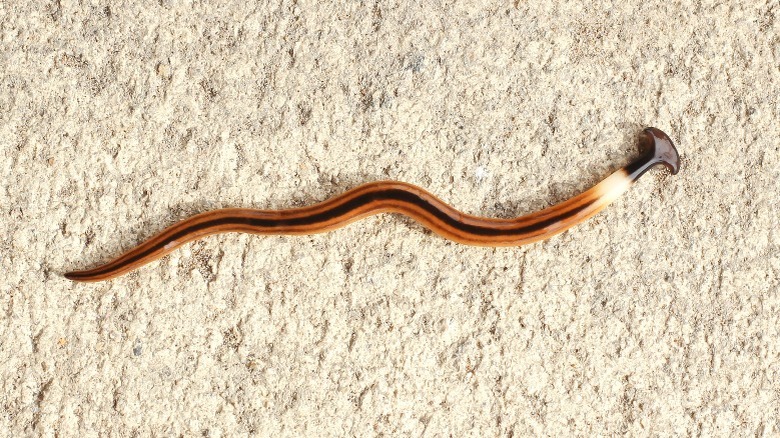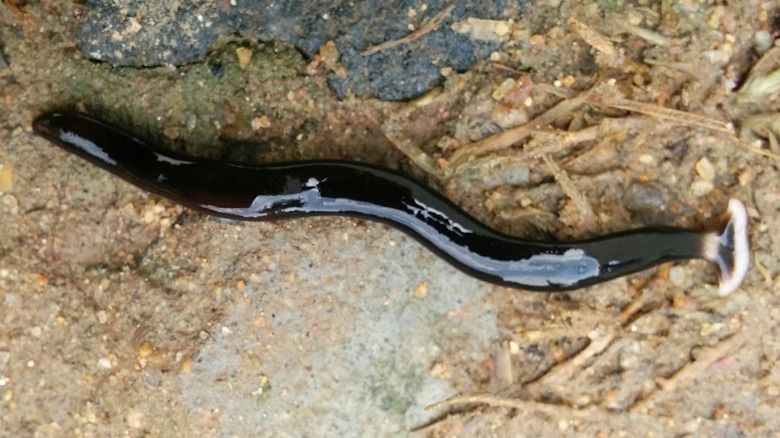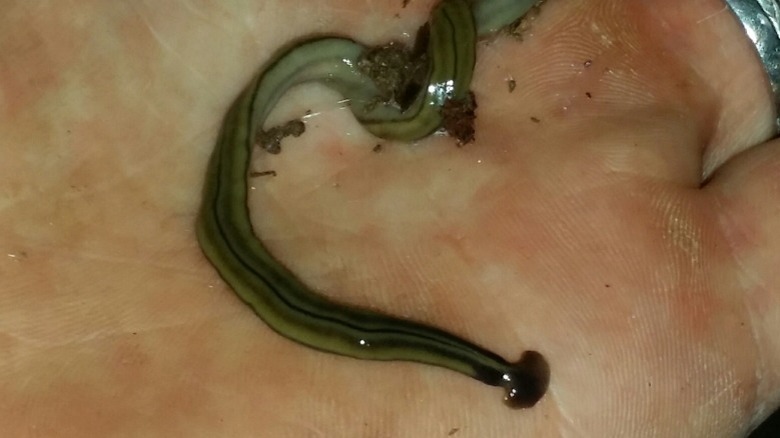The Cannibalistic Hammerhead Worm Explained
Most people have at least a slight aversion to -– if not an all-out phobia of -– spiders, insects, snakes, or anything else that falls under the realm of "creepy crawlies." And, while it may seem unfounded or even comical in the modern age, this fear may have once aided in mankind's survival. According to a 2001 study published in the Journal of Experimental Psychology, the human mind is much quicker at identifying what researchers deem "evolutionarily relevant threats" — like snakes and spiders — than recognizing pretty much anything else. That's because, without medical aid, a bite from such a dangerous venomous animal could spell certain doom.
Although times have changed, we still tend to fixate on potentially threatening creatures whenever they cross our paths. One such "creepy crawler" that has captured the world's attention in recent years is the hammerhead worm. While the word "worm" may not immediately inspire terror, make no mistake: Not all worms were created equal. This is not your average garden friend or defenseless wriggling fishing bait. From deadly neurotoxins to legends of immortality -– and, of course, a famed penchant for cannibalism –- the hammerhead worm is a creature of nightmares.
Hammerhead worms are ancient nocturnal animals
Hammerhead worms belong to an ancient group of animals called land planarians, also known as terrestrial flatworms. These unique critters evolved hundreds of millions of years ago, leaving their aquatic homes –- where many of their flatworm cousins still live — to seek life on land. Biologists have described around 910 species of land planarians as of 2023, though little is known about the habits of these bizarre creatures, and many more mysteries remain unknown to science.
Classified under the genus Bipalium –- which roughly translates to "two shovels" and references their pickaxe-like heads –- hammerhead worms are relatively large as terrestrial flatworms go, with some species measuring almost 20 inches long. As of 2023, there are 62 described species of hammerhead worm, with many featuring striped markings and bright colors. Though some have dark eyespots, they lack true eyes and can only sense light and dark. With their distinctive flattened heads and long snake-like bodies, these worms definitely evoke the same terror as their namesake hammerhead sharks -– at least for small creatures of the forest floor.
Hammerhead worms primarily live in tropical forests, as they require relatively cool, wet environments to stay properly hydrated. But in the right conditions, such as following periods of heavy rains, they can become abundant. Like all land flatworms, they are nocturnal and seldom seen, spending their days hidden beneath rocks, logs, and leaf litter. If it weren't for their characteristic slug-like slime trails, most people would never know they were around.
They are voracious predators
All land planarians are carnivorous, but some take it to another level. Considered top predators of the forest floor, hammerhead worms emerge after dark to hunt for earthworms, snails, slugs, millipedes, and woodlice. They glide along the ground using thick mucus and a special structure called a "creeping sole" -– basically a pad covered in a bunch of tiny hairs –- and patrol for prey by slowly moving their hammerheads back and forth. Using special receptors located in a groove on the underside of their heads, the worms locate a scent and lock on.
Once a worm has a target, it quickly hones in. To capture prey, like a frantically flipping earthworm, the hammerhead worm wraps its body around its victim like a miniature anaconda, ensnaring it in sticky slime and sometimes slicing it into several pieces in the process. As noted in a 2014 study published in PLoS One, they also employ a method biologists call "capping," in which they locate and engulf a victim's head to stop it. Some species even use venom to subdue their often much larger prey.
The hammerhead worm then inserts its pharynx, or throat, into its victim's body, injecting or squirting digestive enzymes in the process. Feeding then commences, with the worm taking up small portions of food at a time and storing the rest within itself for later use. A hammerhead worm's mouth is located on its underside in the middle of its body. Charmingly, it doubles as an anus.
They can clone themselves
When it comes to reproduction, hammerhead worms have options. All species are hermaphroditic -– that is, every worm possesses both male and female reproductive parts, so any two individuals can mate and produce offspring. Following a coupling in which everything is reciprocal, both members of the pair lay an egg case called a cocoon, and tiny baby hammerheads emerge around 21 days later. But this isn't the preferred method for most species.
The most common means of hammerhead worm reproduction is "fragmentation" –- basically a fancy word for self-cloning. Whenever the mood strikes, a hammerhead worm simply sticks its tail end into the soil, contorts its body, and snaps it off. After seven to 10 days, the tailpiece grows its own head and slithers off as a brand new individual. The parent worm also grows a new tail, meaning it can repeat the maneuver a few times each month.
All hammerhead worms have the power to produce a clone at any time, as any piece of the worm separated from the main body will spawn a new worm genetically identical to its parent. After observing this phenomenon in 1814, naturalist John Graham Dalyell noted (via The Atlantic) that planarians could "almost be called immortal under the edge of the knife." Many people have learned about this the hard way when attempting to kill the worms.
Hammerhead worms are toxic
Hammerhead worms have a number of tricks in their arsenal, including sensitive chemoreceptors, sticky slime, and the ability to self-clone. But, as if that's not enough, there's more. In a 2014 study published in PLoS One, researchers determined that some hammerhead worms produce a powerful neurotoxin called tetrodotoxin, which they likely use as both a defensive mechanism and to subdue prey. Prior to the study, biologists believed that only more advanced animals could produce tetrodotoxin. Hammerhead worms are so far the first and only land invertebrates known to use it.
Tetrodotoxin is famously produced by dangerous animals like the blue-ringed octopus and rough-skinned newt. It's also found in pufferfish, which is why eating improperly prepared fugu is a risky venture. According to the Centers for Disease Control and Prevention, tetrodotoxin essentially shuts off nerve transmission and paralyzes all of the body's muscles simultaneously. This inhibits breathing and heart function and can quickly prove fatal without medical intervention. What's worse, despite the fact that tetrodotoxin is one of the world's deadliest toxins, there is no antidote available.
While all of this is certainly scary, there has never been a fatality or serious incident associated with hammerhead worms. That's because you would either have to consume or be bitten by one to suffer effects, both of which are unlikely. Still, hammerhead worm mucus, which is copiously produced during disturbances, can irritate the skin and could potentially harm pets, so caution is advised.
They are notorious cannibals
Being top-level predators, hammerhead worms rely on a constant supply of prey to survive. But what happens when there aren't enough earthworms and snails to go around? Fear not, the hammerhead worm has a fail-safe solution: good old-fashioned cannibalism. Like many other successful animals, including the often invasive American bullfrog, hammerhead worms readily feed on their own kind in the absence of their preferred prey.
According to National Wildlife Magazine, it's something that University of Arizona wildlife biologist Cecil Schwalbe calls "biological bootstrapping," in which a species ensures its survival by essentially holding itself up by its own bootstraps. In bullfrogs, this also encourages young frogs to disperse as far away from their parents as possible, aiding their spread to new environments. It's possible that the same could be true for hammerhead worms.
But, as usual, these unique land planarians take it one step further. When no prey is available –- not even other hammerhead worms –- they can eat themselves. Well, kind of. First, they use up all of their internally stored food reserves, which can usually buy them several weeks. But if that's not enough to get them through the lean times, hammerhead worms will actually digest their own tissues, like reproductive organs, shrinking down in size until conditions improve.
|Featured image by Sreejith Viswanathan via Wikimedia Commons|Cropped and scaled|CC BY 4.0|
Many hammerhead worm species are invasive
Hammerhead worms are certainly fascinating creatures, but interest in them has increased dramatically in recent days for two simple reasons: There seem to be more of them, and they are showing up in all sorts of places. Originally, they were confined to the wet tropical and temperate forests of Asia, Australia, New Zealand, South America, and a few islands in the Indo-Pacific. But, as of 2023, hammerhead worms are now commonly found throughout the world, including parts of Europe and North America.
Starting in 1878, biologists noticed the unusual worms hanging out in greenhouses. In fact, one of the most widespread invasive species, Bipalium kewense, was discovered at London's Kew Gardens, hence its scientific name. It turns out that the worms often hitch rides in the soil of garden plants as they are moved around for the horticultural trade. Finding the warm humid greenhouse environment perfect for their needs, the introduced hammerhead worms begin proliferating in — and sometimes wreaking havoc on –- their new habitats.
The opportunistic worms typically start out by taking over a greenhouse, then move into the surrounding natural areas. Unfortunately, they feed on earthworms, woodlice, snails, and slugs, which are all ecologically important organisms that promote soil health, so their invasion has the potential to be catastrophic for local ecosystems and their native species. Hammerhead worms have quietly invaded many new regions for decades and their full impact remains to be seen. Farmers have already noticed the introduced predator's devastating effects.
|Featured image by Eduard Solà via Wikimedia Commons|Cropped and scaled|CC BY 3.0|
They can carry parasites
There are plenty of reasons to be apprehensive about hammerhead worms. They are ominous looking, slimy, toxic, seemingly invincible, and possibly damaging to local ecosystems. But, to add to this list, they can also harbor the infectious stage of a parasite known to infect humans: the rat lungworm. That's right, a worm within a worm!
According to the Centers for Disease Control and Prevention, the rat lungworm is a parasitic nematode -– a type of roundworm –- that usually infects rats but can also affect the gastrointestinal and central nervous systems of unlucky humans. Symptoms of infection include headaches, nausea, neck stiffness, abdominal pain, vomiting, strange sensations in the limbs, and eye issues. Even more disturbing, the nematode's eggs can become lodged in the capillaries and trigger a severe body-wide inflammation response.
It definitely doesn't sound pleasant. Luckily, the likelihood of catching rat lungworms from a hammerhead worm is extremely low. You would have to eat the worm to become infected, at which point the potentially lethal tetrodotoxin in its tissues would likely cause much bigger problems. It's far more common for humans to contract rat lungworms from eating snails and slugs, which also carry the parasite -– and just so happen to be a favorite snack of hammerhead worms.
|Featured image by Mohammed Rafiq via Wikimedia Commons|Cropped and scaled|CC BY 4.0|
Hammerhead worms have no known natural predators
Perhaps the most terrifying thing about hammerhead worms is that they appear to be unstoppable. Likely owing to the fact that they are toxic and produce irritating slime when handled roughly, they have no known natural predators. And, in areas where they have been introduced, native species have not evolved with the predatory worms, leaving them ill-equipped to tackle them.
According to the North Carolina Cooperative Extension, there have been some reports of amphibians feeding on them. But, as of 2023, the biggest threat to a hammerhead worm remains another hammerhead worm. This could be advantageous for all involved, as biologists hope that the worms' own cannibalistic tendencies will help keep introduced populations in check. While hammerhead worms are fascinating animals and are important species in their native ecosystems, they have the potential to inflict real harm in areas where they don't belong.
For this reason, biologists recommend that humans become top predators and take on the task of killing the worms in areas where they are not indigenous, which is pretty much anywhere in Europe or North America. Despite fears that they are invincible, hammerhead worms are actually quite delicate and can be killed using alcohol, salt, citrus oil, vinegar, or hot water. Even dry paper towels will fatally desiccate them. "They are very mortal," Ashley Morgan-Olvera, research and education director of the Texas Invasive Species Institute, told Texas Monthly. "They do not survive vinegar or salt."
|Featured image by Scadgrad via Wikimedia Commons|Cropped and scaled|CC BY 4.0|








